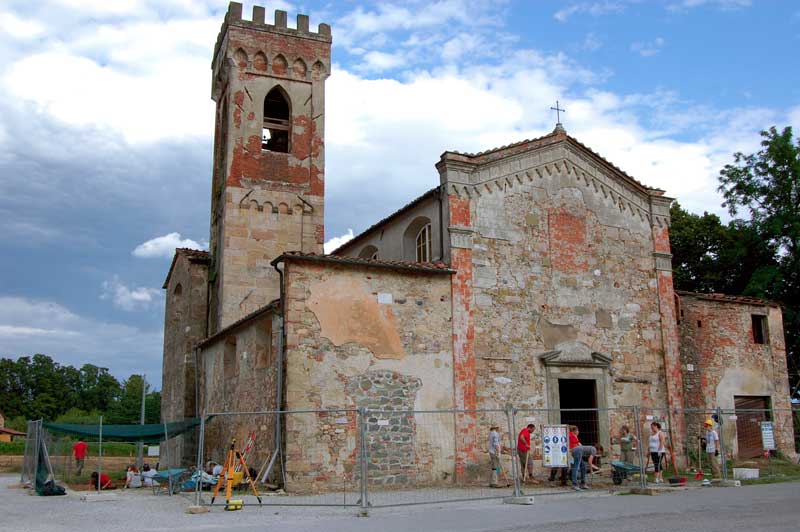Fieldwork
This listing expired on July 1, 2019. Please contact info@irlabnp.org for any updated information.

Location: Altopascio, LU, IT
Season: June 17, 2019 to August 9, 2019
Session Dates: Session One: June 17th to July 12th, Session Two: July 15th to August 9th
Application Deadline: June 1, 2019
Deadline Type: Rolling
Website: http://www.paleopatologia.it/Badiapozzeveri/Fieldschool/
Program Type:
Field school
RPA Certified:
no
Affiliation:
University of Pisa
Project Director:
Prof. Gino Fornaciari
Project Description:
The Field School in Medieval Archaeology and Bioarchaeology at Badia Pozzeveri (Lucca, Italy) is an academic program aimed at training students in archaeological and bioarchaeological field and laboratory methods
Excavations take place at the church of “San Pietro a Pozzeveri” in the municipality of Altopascio. Badia Pozzeveri is located approximately 10 miles east of the city of Lucca, capital of the Tuscan province of the same name. San Pietro’s church was once part of a Camaldolese monastery, which was founded in the 11th century on the shores of Lake Bientina. The medieval lake, now entirely dried up, extended between Lucca and the Arno River. The monastery flourished during the 12-13th centuries thanks to its location along the Via Francigena, a major trade and pilgrimage route, which connected France and Northern Europe with Rome throughout the entire Middle Ages. The monastery’s decline started in the 14th century and eventually led to its dissolution in the 15th century. San Pietro’s church remained as the village’s center of worship and is still in use.
Previous excavations conducted at the site (2011-2017) exposed human burials dated to the middle ages, the renaissance and modern times. Additionally, archaeological investigations revealed the buried remnants of a medieval building of monastery adjacent to the church, as well as structures belonging to the medieval church and cloister. During the 2018 field season, the field school will continue to explore the medieval levels of the site, including the cemetery and the monastery’s ruins.
The field school is part of a broader academic collaboration between The Ohio State University and the University of Pisa investigating biocultural complexity in the region surrounding Lucca during the Middle Ages. Specifically, the research project has the following objectives:
The field school at Badia Pozzeveri is an outstanding opportunity for students to gain practical experience in archaeological excavation and bioarchaeological investigation by working side-by-side with leading researchers in the field. The field school is designed to provide participants with knowledge of archaeological field methods – including survey, excavation, and GIS (Geographic Information Systems) – and bioarchaeological field and research methods – recovery, restoration, and analysis of human skeletal remains. Practical, hands-on experience in the field will be complemented by laboratory activity in archaeology and bioarchaeology. Lectures by the directors and instructors on their research will also provide students with insights in the theory and practice of archaeology and physical anthropology.
Period(s) of Occupation: Medieval
Project Size: 1-24 participants
Minimum Length of Stay for Volunteers: 4 weeks
Room and Board Arrangements:
Room and Board are provided by the Field School. Excavation will take place daily, Monday through Friday, between 8:00 am and 6:00 pm, with an hour lunch break. At the beginning of the field school, the instructors will divide the students in four groups and each group will be assigned to a specific excavation area. Area assignments are based on a variety of factors, including experience and interests, and decisions are final. Given the didactic value of direct involvement in – and observation of the progression of – archaeological investigation, students are expected to actively contribute to the excavation of their area for the entire duration of the field school. The excavation areas at Badia Pozzeveri differ somewhat in their investigation focus and there is no guarantee that all participants will be equally involved in the excavation of human remains. Laboratories will be held in parallel with excavation. Laboratory activities may include cleaning, labeling, restoring, and analyzing skeletal remains and artifacts, as well as elaboration of photographs and GIS records. Such activities will be held at the instructors’ discretion and will involve only small groups of students (2-3 per lab) at a time. Lectures may be given in the morning once or twice a week. In case of inclement weather, excavation will be replaced with laboratory activities and lectures. At the end of the working day students will have time to relax and shower. Students and staff will dine together at 8:00 pm-8:30 pm. Cost: $2250 for one session, $4000 for two sessions
Academic Credit:
12 credits or 24 credits through the University of Pisa credits offered by University of Pisa. Tuition is COST: $2,250 (1 session) / $4,000 (2 sessions).
Dr. Francesco Coschino
Badia Pozzeveri Field School
Altopascio
Italy
The AIA is North America's largest and oldest nonprofit organization dedicated to archaeology. The Institute advances awareness, education, fieldwork, preservation, publication, and research of archaeological sites and cultural heritage throughout the world. Your contribution makes a difference.
Notifications